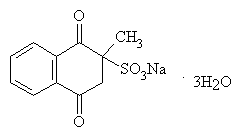Photosensitizing activity of
2,3-dihydro-2-methyl-1,4-naphthoquinone,
a synthetic analog of vitamin K.
Elena N. Makareyeva, Elena L. Lozovskaya, Igor I. Sapezhinskii
Institute of Biochemical Physics Russian Academy of Sciences,
Moscow, Russia
Introduction.
The impact of the increased environmental ultraviolet radiation can result in negative consequences on human beings. Depletion of ozone layer, a natural light filter, is a global ecological problem. With ozone hole formation the intensity of UV-radiation below 300 nm would sharply increase, short-wave boundary would shift to UVC range. This would cause higher rates of photodamage of eyes and skin (photokeratit, cataract, erythema, skin aging and skin cancer), inhibition of cell immunity. These reasons induce enhanced interest in investigation concerning photosensitization. The hazard of UV-irradiation to human health increases when photosensitizers are present in organism. Some drugs, metabolites, food dyes, preparations from plants and others can behave as photosensitizers. Therefore, it is necessary to search for the compounds, which absorb light in UV-range and could act as potentially harmful photosensitizers.
Vitamin K and it’s analog.
Vitamin K is antihemorragic vitamin. It takes part in prothrombin formation and promotes blood coagulation in normal. Vitamin K is widespread in plants especially in green leaves of alfalfa and spinach, in cauliflower, fruit of wild rose, pine needles, green tomatoes. Some methylnaphthoquinone derivatives have the same property as vitamin K.
We have studied 2,3-dihydro-2-methyl-1,4-naphthoquinone (MNQ). This substance is a synthetic water soluble analog of vitamin K.
